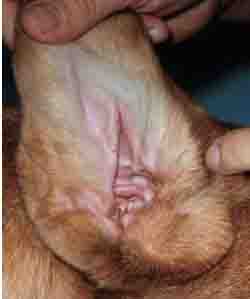Middle And Outer Labrador
Dog Ear Problems
Inner and middle ear infections are common in a Labrador dog or all dogs for that matter. The condition is easily treated if caught early. They are caused by bacteria that is able to colonize in the ear. This can be due to a depressed immune system or other condition favorable to the bacteria such as an allergy that causes ear inflammation. The inflammation creates conditions that make it easier for bacteria or yeast to take hold. Other common causes are dog ear mites, ear tumors, foreign objects that get caught in the ear. Basically anything that allows moisture build-up and a byproduct of moisture, which is infection.
Dog ear infections are often seasonal, particularly in the case of allergies, foreign objects such as grass blades caught in the ear or swimming. Floppy eared dogs like the Labrador dog in particular are prone to yeast infections if water gets trapped in the ear.
Ear infections in any dog can be painful to the point where the pet may act tired and refuse to engage or play.

The visible or inner side of a healthy dog ear should be a bright pink color. There may some black discharge in a healthy dog ear. A dog with an ear infection will have redness, ear odor, ear scratching, head shaking, and the rubbing of the ears on various surfaces such as furniture.
Source: Washington State University
Inner and Middle Dog Ear Infections
The two parts of the ear, middle and inner, are separated by the ear drum. Anything on the inner side of the ear drum cannot be seen from the outside. Infection that travels into the inner or middle ear must be treated early to avoid deafness or harm to the ear. This is important since this part of the ear controls hearing and balance. Because of this, canine ear problems in this area cause neurological and balance related issues.

What is the cause of a canine middle ear infection?
Causes of infections in the canine middle and inner ear are the result of an infection which starts in the outer ear. Culprits include Strep, Staph, and Malassezie (Pseudomonas bacteria) or Candida yeast. It is less common, but possible, for an infection to travel from the mouth to the ears via the auditory tube.
As mentioned above, the infection takes hold due to a change in ear or immune system condition caused by mites, allergy, foreign objects such as a blade of grass or swimming.
What are the symptoms of a Dog Ear Infection?
Symptoms o middle and inner ear infections are comparable outer ear infections. Symptoms include canine ear pain, bloody discharge, scratching, pawing or scratching the ear and shaking of the head.
Infections that become more chronic or severe can cause paralysis of teh face on the side of the infected ear due the inflammed facial nerves that runs next to the middle ear. Symptoms of canine facial paralysis are trouble swallowing, eyelids that droop, drooping face muscles, and a third eyelid that partially covers the eye surface.
When the bacterial ear infection moves from the outer to inner ear, signs include vertigo like balance problems, the head tilting down and circling behavior.
How are Canine Ear Infections Diagnosed?
Middle and inner ear infections are diagnosed with a thorough
otoscopic exam and x-rays of the head. Animals usually need to be
anesthetized so that they can be properly examined and so that the ear
can be flushed and treated. A veterinarian will also test any canine ear discharge.
A ruptured eardrum or an eardrum that is discolored and bulging with fluid is an indicator of a middle and possibly inner ear infection. Most cases of middle and inner ear infections usually have signs of an outer ear infection as well, but not always.
Dog Ear Infection Treatment
Treatment varies depending on the severity of the disease. Bacteria may be tested in a lab to determine the specific antibiotic to prescribe. In mild infections, oral or injectable antibiotics in combination with topical antibiotics and anti-fungal agents are often used. In more severe or chronic cases, the eardrum may need to be surgically incised and the middle ear cleaned, flushed and treated.
Most dogs require the ear to be cleaned multiple times, a task that can be accomplished at home. The veterinarian will teach an owner how to clean the ear. Only use products made for dog ear cleaning such as Nutrivet since rubbing alcohol can burn the ear and hydrogen peroxide can also have side effects.
In some cases, more invasive surgery of the Labrador dog ear including removal of part of the bony covering of the ear (bulla) through a lateral or ventral bulla osteotomy may need to be performed. In very severe cases, complete removal and closure of the entire ear canal (total ear ablation) may be necessary.
In cases where tumors, feline polyps, allergies, or other factors contribute to the cause of the infection, they must also be properly identified and treated for the entire treatment to be successful.
The dog ear infection should begin to clear in as little as 3 days, with the infection completely gone in 2 weeks. Dogs must be retested after 2 weeks to ensure that the infection is completely cured.
Dog Ear Infection Prevention
While not all middle and inner ear problems can be prevented, the vast majority of them can.Early diagnosis and prompt treatment of the more common outer ear infections will prevent most middle and inner ear infections.
Controlling ear mites and allergies, along with good routine ear cleaning and care are the key to preventing all ear infections. A natural remedy designed to keep ear flora in balance such as Ear Dr. may also be of help, particularly in the Labrador dog ear since the long ear length could predispose an animal to problems.
Have A Labrador Retriever Ear Health Question for our Veterinarian?
Do you have a Labrador Retriever ear related question for our Vet? We'll answer it for FREE! Just fill out this form and our Vet will get back to you as soon as possible.
Please include information such as the sex, medical history, medications, changes in behavior, when symptoms first appeared and anything else you believe would be helpful. Please send a picture to help us understand the ear problem.
Questions are answered on a first come, first served basis and may take some time depending on the number we receive. If you have an urgent question, we suggest using this low cost online veterinary question service that has Vets standing by 24 hours a day, 7 days a week to help.
Related Labrador Dog Articles
Labrador Health - An Overview
Labrador Dog Dental Health
Guide to Treating Dog Ear Infections
From Labrador Dog Ear Problems to Labrador Retriever Guide Home Page